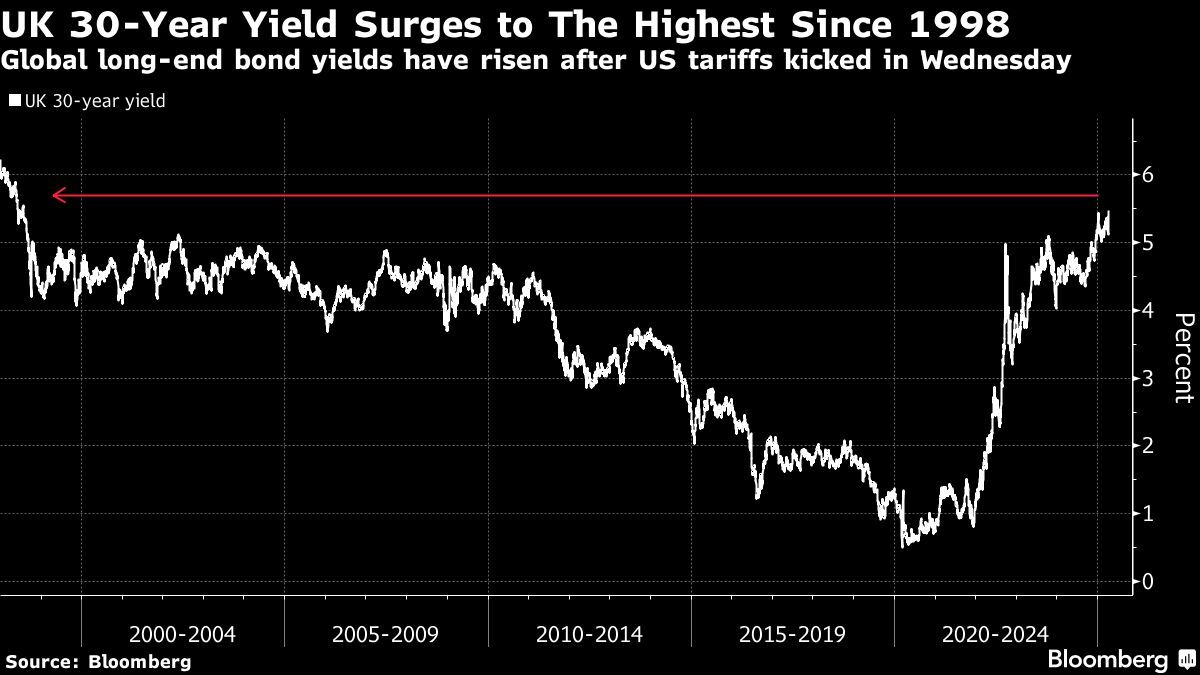
(April 9): The UK’s borrowing costs surged to the highest since 1998 as a jump in long-dated US rates radiated around the world.
Yields on 30-year gilts climbed 17 basis points to 5.51%, exceeding an earlier multi-decade high in January. At the same time, the pound slumped to its lowest in one year against the euro.
A sustained move higher in UK government borrowing costs will create a headache for Chancellor Rachel Reeves, who already has little fiscal headroom to spur economic growth and has had to reduce spending to balance the budget.
UK long-end bonds have been particularly hard hit since Reeves revealed increased borrowing plans in October. Short-end debt has been cushioned by the prospect for more interest-rate cuts from the Bank of England.
The appetite for fresh UK debt will soon become apparent, with the Debt Management Office set to sell up to £4.5 billion (US$5.8 billion or RM25.95 billion) of five-year notes on Wednesday. The bidding deadline is 10am in London with results to follow a few minutes later. A sale of 30-year debt on Tuesday was oversubscribed 3.04 times, higher than the 2.85 times seen at auction a month ago.
While bonds rallied in the wake of US President Donald Trump announcing global tariffs last week, they are now taking a hit as traders are liquidating assets in a dash for cash. Although there may be some optimism that trade deals can be struck with the US, Megum Muhic, a strategist at RBC, says there is potential for disappointment.
New havens
With an escalating tariff war now upending expectations for growth and spending around the world, investors are searching for new havens.
The euro has emerged as an unlikely winner from Trump’s bid to redraw the global trade order. Despite Europe being worse hit than the UK by levies, market participants see the euro being a bigger beneficiary as the sizeable inflows into dollar assets of recent years reverses.
That’s driven the pound down against the euro. The common currency rose as much as 0.6% to above 86 pence, its strongest level since April 2024. The euro has also outperformed most Group-of-10 peers over the past month, after rebounding from a whisker away from parity against the dollar earlier this year.
An aggressive ramp-up in spending from Europe’s biggest economy is also seen as a game changer for growth, while the UK government is less able to support its economy with spending, given its limited fiscal headroom.
Options markets are flashing renewed confidence in the euro over the pound, with so-called one-month risk reversals now showing the strongest tilt toward the common currency since Jan 21. More than three quarters of options that traded this week and reference the euro-pound pair are targeting gains for the common currency.
Uploaded by Chng Shear Lane
- Taiwan's TSMC warns of limits of ability to keep its AI chips from China
- West Coast Expressway operator receives government consent for RM1.15b financing from Bank Pembangunan
- Huawei readies new AI chip for mass shipment as China seeks Nvidia alternatives — Reuters
- CATL teases five-minute EV charging with longer range than BYD
- 1MDB-Tanore: BNM told Deutsche Bank that split in US$1b remittance was 1MDB’s ‘business decision’ — witness

